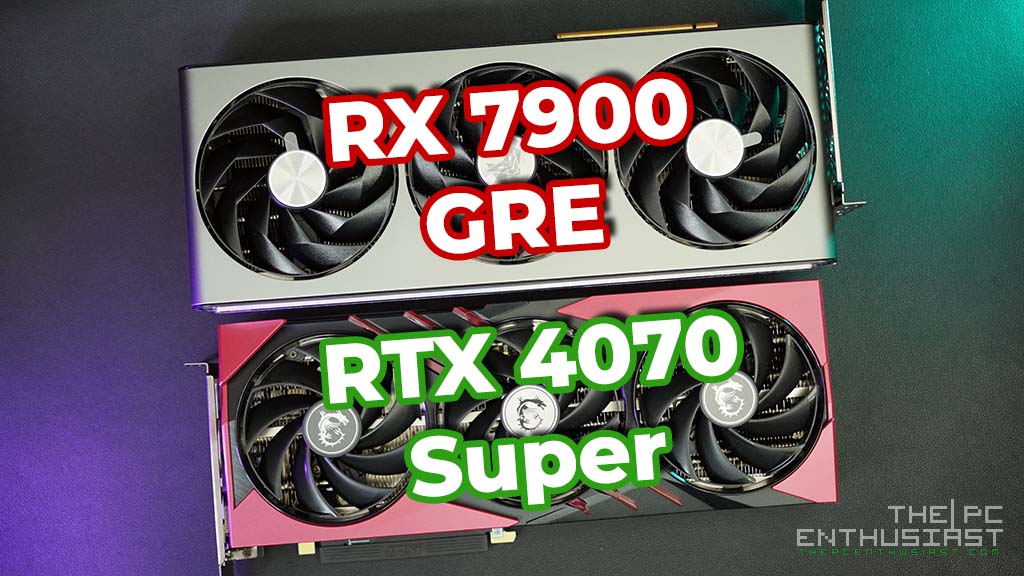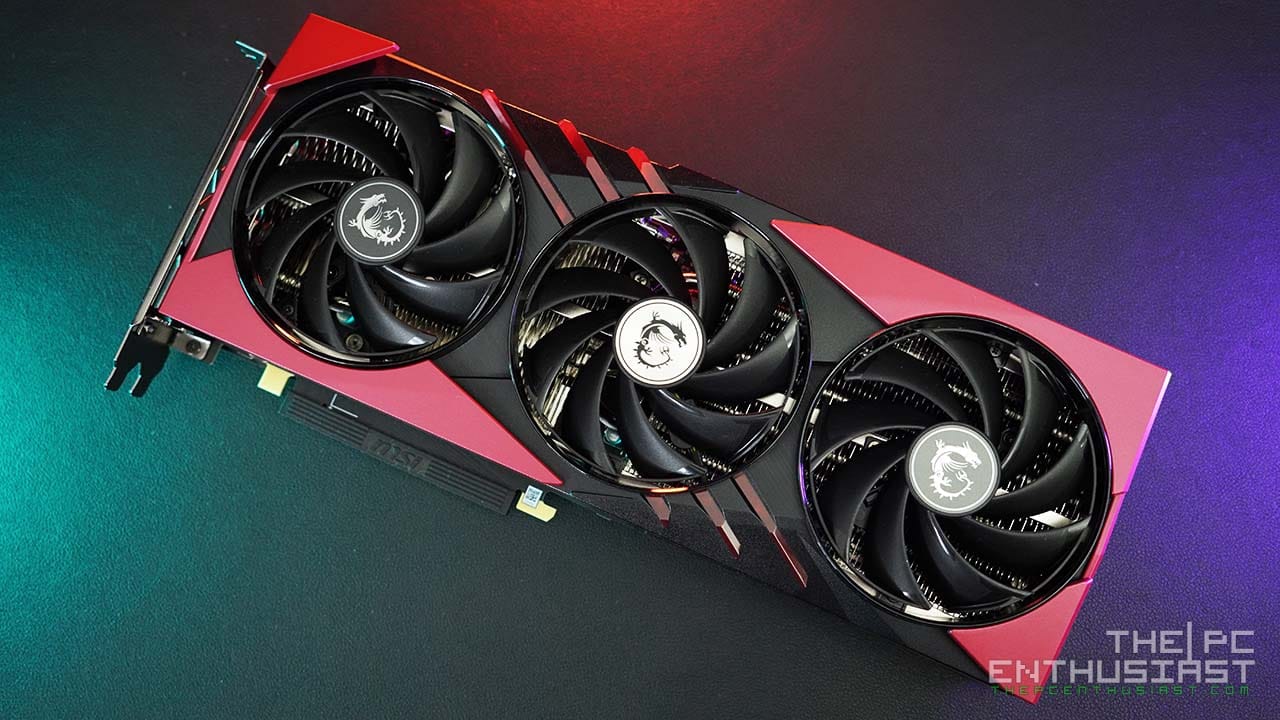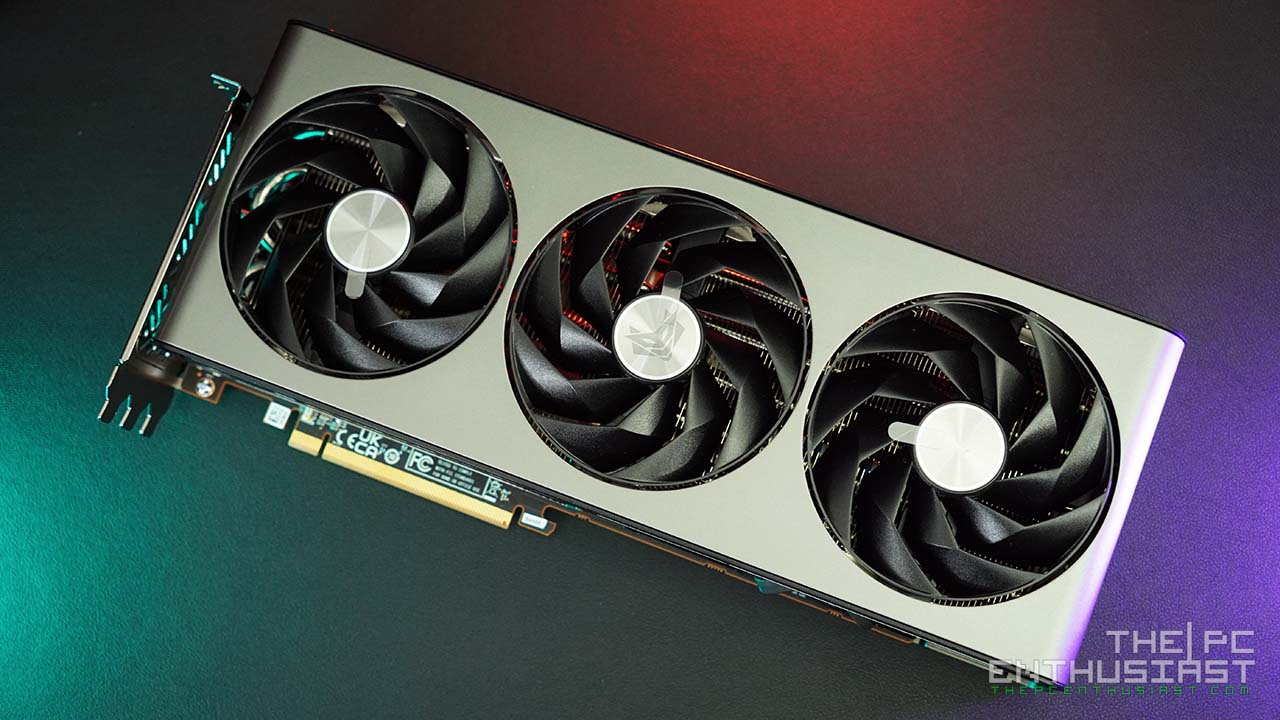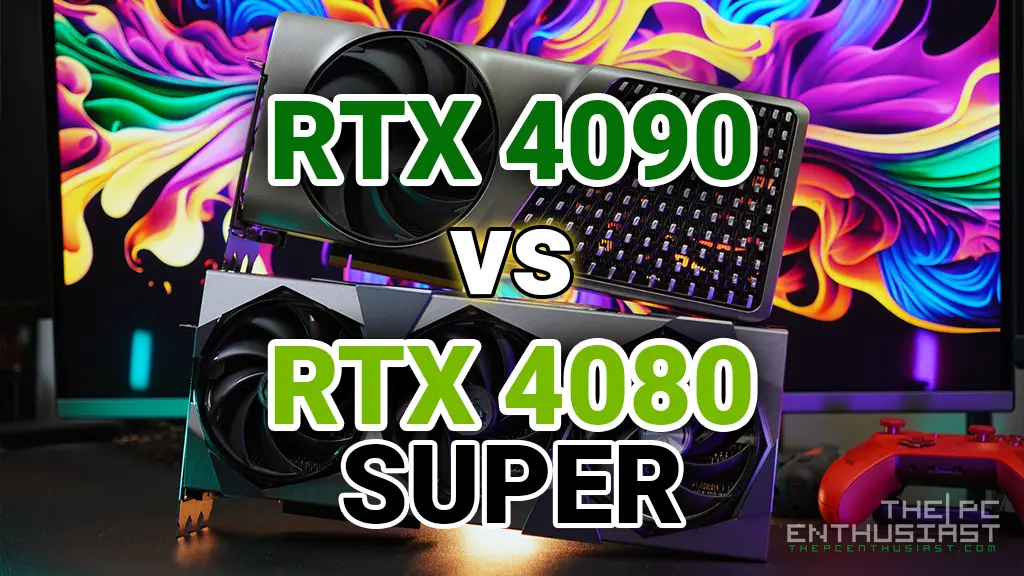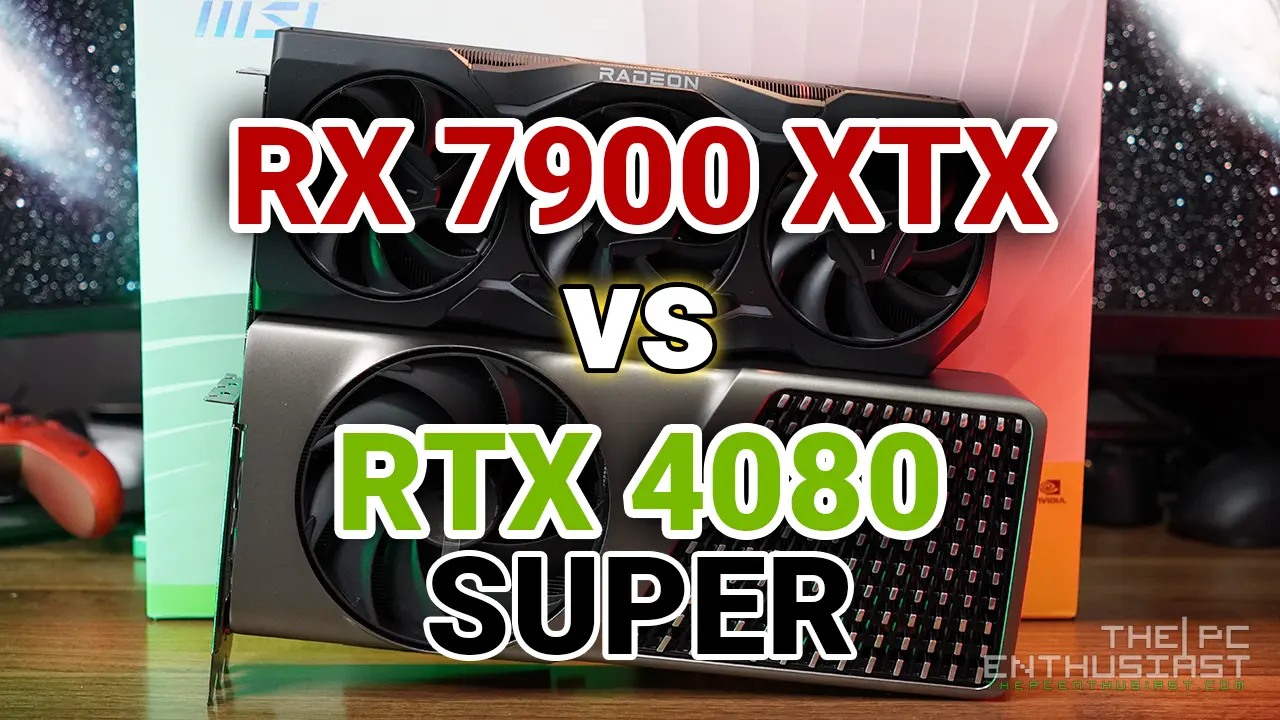Finally, we got our hand on AMD’s latest and fastest GPU – the Radeon RX 7900 XTX. It’s been a few months since AMD announced its 7900 series GPUs, and it’s been in the market for around two months now. Despite being AMD’s current flagship GPU, it doesn’t compete with NVIDIA’s current flagship, the RTX 4090. Instead, the RX 7900 XTX directly competes with the RTX 4080 – a $1,200 GPU. The RX 7900 XTX is cheaper by $200 at MSRP, but can it outperform the competition? Will the RX 7900 XTX offer a better value than the RTX 4080? In our review below, let’s find out how the Radeon RX 7900 XTX performs.

UPDATE: Some custom-designed Radeon RX 7900 XTX graphics cards are selling below MSRP. More details below.
AMD Radeon RX 7900 XTX RDNA 3 Graphics Card Review
By now, many of you are perhaps aware of or have an idea about AMD’s latest GPUs and RDNA 3 architecture. AMD uses a chiplet design in a gist, combining 5nm and 6nm process nodes. Each node has its specific function, and by doing this, AMD was able to keep the GPU’s cost lower while offering better performance than its predecessor.

According to AMD, the breakthrough architecture delivers up to 54% more performance per watt than AMD RDNA 2 architecture and features the world’s fastest interconnect linking the graphics and memory system chiplets at up to 5.3 TB/s. It also offers up to 96 new unified compute units, second-generation AMD Infinity Cache™ technology, and up to 24 GB of high-speed GDDR6 memory with up to a 384-bit memory interface. It also includes increased AI throughput that delivers up to 2.7X higher AI performance, and second-generation raytracing technology that provides up to 1.8X higher raytracing performance than AMD RDNA 2 architecture.


Below are the key features of the new Radeon RX 7900 Series GPUs.
Key Features
- AMD RDNA 3 Architecture – Featuring an advanced chiplet design, new compute units and second-generation AMD Infinity Cache technology, AMD RDNA 3 architecture delivers up to 54% more performance per watt than the previous-generation AMD RDNA 2 architecture. New compute units share resources between rendering, AI and raytracing to make the most effective use of each transistor for faster, more efficient performance than the previous generation.
- Chiplet Design – The world’s first gaming GPU with a chiplet design delivers up to 15% higher frequencies at up to 54% better power efficiency. It includes the new 5nm 306mm2 Graphics Compute Die (GCD) with up to 96 compute units that provide the core GPU functionality. It also includes six of the new 6nm Memory Cache Die (MCD) at 37.5mm2, each with up to 16MB of second-generation AMD Infinity Cache technology.
- Ultra-Fast Chiplet Interconnect – Unleashing the benefits of second-generation AMD Infinity Cache technology, the new chiplets leverage AMD Infinity Links and high-performance fanout packaging to deliver up to 5.3TB/s of bandwidth.
- Expanded Memory and Wider Memory Bus – To meet the growing requirements of today’s demanding titles, the new graphics cards feature up to 24GB of high-speed GDDR6 memory running at 20Gbps over a 384-bit memory bus.
- Dedicated AI Acceleration and Second-Generation Raytracing – New AI instructions and increased AI throughput deliver up to 2.7X more performance than the previous AMD RDNA 2 architecture, while second-generation raytracing technology delivers up to 1.8X more performance than the previous generation.
- DisplayPort™ 2.1 Support – The industry’s only high-end gaming graphics cards to support DisplayPort 2.1 technology with UHBR 13.5, offering up to 54Gbps of display link bandwidth and enabling high-refresh 4K (up to 480Hz) or 8K (up to 165Hz) gaming on next-gen displays.
- New AMD Radiance Display™ Engine – Provides 12 bit-per-channel color for up to 68 billion colors and higher refresh rate displays compared to AMD RDNA 2 architecture and includes support for DisplayPort 2.1 and HDMI 2.1a.
- High-Refresh Gaming – DisplayPort 2.1 provides increased display bandwidth compared to DisplayPort 1.4, with the ability to support up to 900Hz, 480Hz and 165Hz refresh rates for 1440p, 4K and 8K displays, respectively.
- Dual Media Engine – Supports simultaneous encode or decode streams up to 8K60 for HEVC and supports AV1 encode, delivering up to 1.8X higher engine frequency than AMD RDNA 2 architecture.
Below is a detailed specification of the AMD RX 7900 Series, including its predecessors.
AMD Radeon RX 7900 GPU Specifications
| AMD Radeon RX 7900 XTX | AMD Radeon RX 7900 XT | AMD Radeon RX 6950 XT | AMD Radeon RX 6900 XT | |
|---|---|---|---|---|
| Manufacturing Process | GCD: TSMC 5nm MCD: TSMC 6nm | GCD: TSMC 5nm MCD: TSMC 6nm | TSMC 7nm | TSMC 7nm |
| Transistor Count | 58B | 58B | 26.8B | 26.8B |
| Architecture | RDNA3 | RDNA3 | RDNA2 | RDNA2 |
| GPU | Navi 31 | Navi 31 | Navi 21 | Navi 21 |
| Stream Processors | 6144 | 5376 | 5120 | 5120 |
| Compute Units | 96 | 84 | 80 | 80 |
| ROPs | 192 | 192 | 128 | 128 |
| Infinity Cache | 96MB | 80MB | 128MB | 128MB |
| Game Clock | 2300 MHz | 2000 MHz | 2100MHz | 2015MHz |
| Boost Clock | 2500 MHz | 2400 MHz | 2310MHz | 2250MHz |
| Memory Size Type | 24GB GDDR6 | 20GB GDDR6 | 16GB GDDR6 | 16GB GDDR6 |
| Memory Clock | 20 Gbps | 20 Gbps | 18 Gbps | 16 Gbps |
| Memory Bus Width | 384-bit | 320-bit | 256-bit | 256-bit |
| TDP | 355W | 300W | 335W | 300W |
| Release Date | December 13, 2022 | December 13, 2022 | May 10, 2022 | December 8, 2020 |
| Launch Price | $999 | $899 | $1,099 | $999 |
Check the latest pricing and availability: (#ad)
AMD Radeon RX 7900 XTX graphics cards are available on Amazon.com here.
Radeon RX 7900 XT graphics cards are available on Amazon.com here.
Packaging and Closer Look



I have the reference AMD Radeon RX 7900 XTX here, and its compact, slim box is refreshing to see. Graphics cards from AIC partners are usually big, unnecessarily big. AMD’s packaging is simple, yet the unboxing experience was quite nice. When you open the box, the graphics card moves towards you or is being lifted by a hinge behind it.


Unlike the RTX 40 series graphics cards, AMD’s Radeon RX 7900 XTX is only a three-slot graphics card. It measures 287mm in length, feels solid on hand, and is heavier than the RX 7900 XT. It has a triple fan design with zero RPM mode, and I noticed that the fan blades are connected to an outer ring. According to AMD, these are custom-designed axial fans, and the crazy thing about them is that there is a fan intake temperature sensor.


I didn’t open or dismantle my 7900 XTX, but you can check the slides above showing us what’s under the hood.


Surprisingly, the output ports are a bit different this time around. The Radeon RX 7900 XTX has two DisplayPort 2.1, an HDMI 2.1a, and a USB Type-C port. The last time I saw a USB Type-C port on a graphics card was on NVIDIA’s RTX 2080 (Super/Ti) Founders Edition cards. At the rear end of the graphics card are mounting holes to secure the card on the chassis and prevent the card from sagging.


The Radeon RX 7900 XTX uses only two 8-pin PCIe power connectors. Custom RX 7900 XTX cards from AIC partners might require at least three 8-pin PCIe power connectors. But the good thing about this is that you don’t need to buy a new power supply since AMD uses the good old, tried and tested 8-pin PCIe power connector.
Radeon RX 7900 XTX vs 7900 XT Graphics Card Size
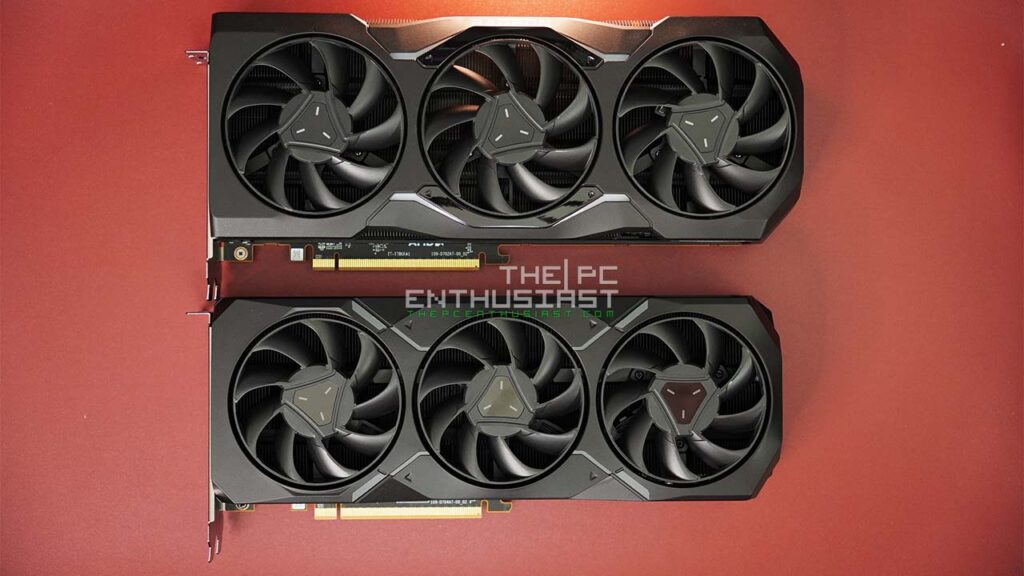


At first, I thought the only difference between the RX 7900 XTX and RX 7900 XT’s design was the RGB lighting. However, while swapping the cards on the test setup, I noticed that the RX 7900 XT is lighter. When I put them side by side, the RX 7900 XT is not only lighter, but it’s slightly smaller as well.
I still like the design of the RX 7900 XT, but I wish AMD didn’t remove the RGB lighting. Most importantly, I wish they gave the RX 7900 XT a different name. It’s very confusing and somewhat misleading or deceptive. There’s only a single “X” that differentiates them.
Okay, time to see how this graphics card performs.
Radeon RX 7900 GPU Series Test Setup Review

I’m using an X670E motherboard with an AMD Ryzen 7 7700X to test the two Radeon RX 7900 series graphics cards. It is paired with a DDR5-5600MHz CL36 memory kit with the AMD EXPO profile enabled. Resizable BAR was also enabled from the BIOS settings. Below are the rest of the specifications of the system:
| Operating System | Windows 11 Pro |
| Processor | AMD Ryzen 7 7700X |
| Motherboard | MSI MPG X670E Carbon WiFi |
| Memory | Corsair Vengeance RGB DDR5-6000MHz CL30 AMD EXPO |
| Graphics Card | AMD Radeon RX 7900 XTX AMD Radeon RX 7900 XT |
| OS Drive | MSI Spatium M480 Play |
| Game Drive | SanDisk Extreme PRO Portable SSD V2 and Extreme Portable SSD V2 |
| Power Supply | MSI MPG A1000G PCIE5 |
| Chassis | MSI MPG Velox 100P Airflow |
| Monitor | MSI Optix MPG321UR-QD 4K 144Hz |
I used AMD’s Adrenalin 23.1.1 driver in testing the RX 7900 XTX. It was tested in three resolutions – 1920×1080 FHD, 2560×1440 WQHD, and 3840×2160 4K UHD.
For synthetic benchmarks, I used 3DMark’s benchmark suite. I also used the following games to test the graphics card: Assassin’s Creed Valhalla, A Plague Tale: Requiem, Call of Duty Modern Warfare II, Deus Ex Mankind Divided, Horizon Zero Dawn, Monster Hunter World, Read Dead Redemption 2, Shadow of the Tomb Raider, The Division 2, and Watch Dogs Legion.
I also tested the RX 7900 XTX with Cyberpunk 2077, Forza Horizon 5, and The Witcher 3 Next-Gen for the ray tracing-featured games.
Below is the GPU-Z screenshot of the Radeon RX 7900 XTX.

AMD Radeon RX 7900 XTX Benchmarks
Synthetic Benchmark Results
Below are the results that I got with 3D Mark’s benchmark suite. Note that in this review, I also included the results I got for the Radeon RX 7900 XT, but I will have a separate review for it.







Based on the synthetic benchmarks I got, the Radeon RX 7900 XTX performed remarkably well. It was able to outperform NVIDIA’s RTX 4080 in most tests. However, if you look at the Port Royal and Speed Way benchmark results, the 7900 XTX didn’t stand a chance against the RTX 4080’s ray tracing capabilities. The RX 7900 XTX is undoubtedly fast, and if you look at it, its ray tracing performance is better than the RX 6900 XT. But ray tracing is still not AMD’s GPU’s forte at the moment.
1080p Game Benchmark Results
Honestly, I would not recommend getting any of these high-end graphics cards for 1080p gaming. The CPU/resolution bottlenecks these cards; they just don’t perform well in lower resolutions. The RX 7900 XTX is more suited for 1440p or 4K gaming. However, if you are curious to see how the 7900 XTX performs on a 1920×1080 monitor, below are the results I got.









At 1080p, the Radeon RX 7900 XTX trade blows with the RTX 4080 graphics card. There are some games where the 7900 XTX would outperform the RTX 4080. And there are also other game titles where its competition would outperform it. Nevertheless, both the RX 7900 XTX and RTX 4080 are bottlenecked in this resolution.
1440p Game Benchmark Results
Going up to 1440p, the Radeon RX 7900 XTX has more room to “stretch its legs” a bit. Below are the results that I got.
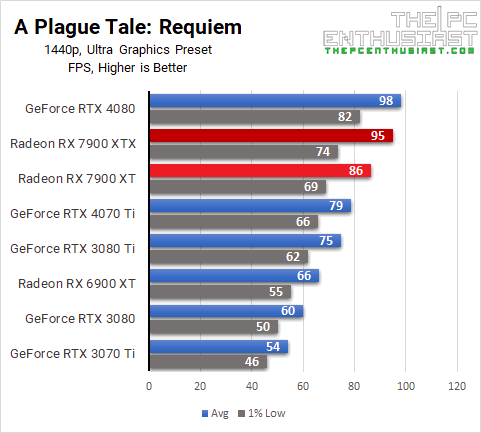








At 1440p, the Radeon RX 7900 XTX outperformed the RTX 4080 in most game titles. While in some game titles like A Plague Tale: Requiem, the RX 7900 XTX is just a few fps behind the RTX 4080. Their actual difference would be unnoticeable while gaming.
2160p Game Benchmark Results
Finally, at 4K, the GPUs will have all the room they need to push hard. At this resolution, it would be primarily GPU-bound, and only the fastest graphics cards in the market can drive games above 60 fps. See how the RX 7900 XTX performs at 4K UHD resolution below.
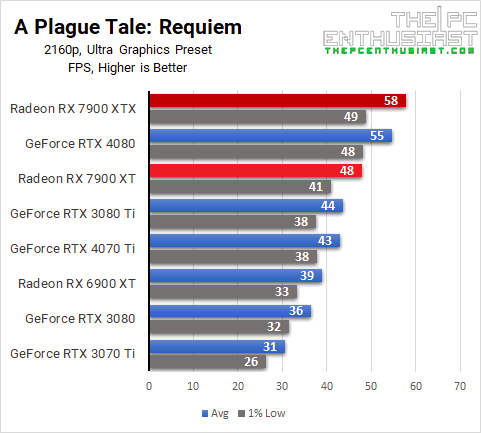








The Radeon RX 7900 XTX performed remarkably well at 4K UHD resolution. Although not by a considerable margin, it outperformed the RTX 4080 in most game titles above.
So far, we have only tested the Radeon RX 7900 XTX in traditional rasterization. And we can see that its performance is very impressive. Next, let’s see how it performs in ray tracing or games with upscaling technology.
Radeon RX 7900 XTX Ray Tracing and FSR Benchmark Results
Call of Duty Modern Warfare II
First on the list is Call of Duty Modern Warfare II. This game doesn’t have ray tracing features, but it has FSR support. For those unfamiliar with FSR, it is AMD’s solution to NVIDIA’s DLSS. It’s AMD’s upscaling technology. Unfortunately, at this time, AMD doesn’t have frame generation technology yet. Maybe in the future, AMD will have an answer to NVIDIA’s DLSS 3 (AI Frame Generation).


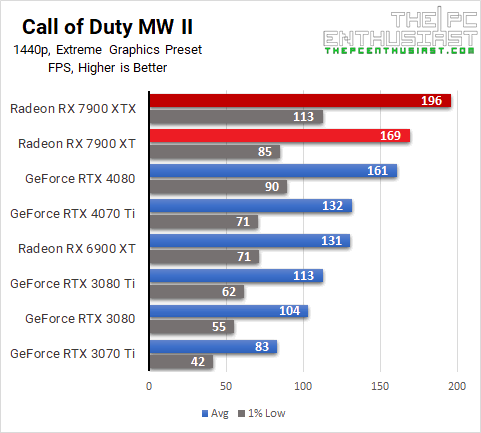

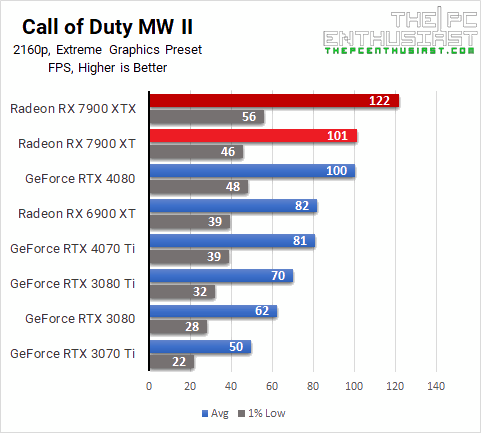

The Radeon RX 7900 XTX perform well in this title. The RX 7900 XTX and 7900 XT outperformed the RTX 4080 in traditional rasterization and with upscaling enabled. I am using FSR Quality settings, so you could get higher frame rates if you opt for performance or other aggressive settings, albeit at the expense of graphics quality.
Cyberpunk 2077
Cyberpunk 2077 is one very graphics-intensive game. And this game has been NVIDIA-leaning since its release. Below you can see the 1080p, 1440p, and 2160p results. In each resolution, you can see traditional rasterization, then with ray tracing only, and finally, ray tracing with upscaling technology enabled.
Here are the results for 1080p resolution:



Below are the results for 1440p resolution:
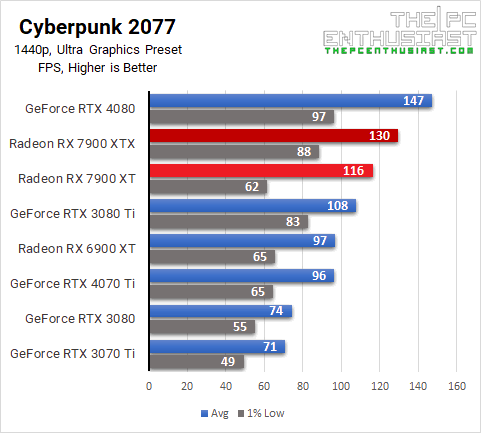


Finally, here are the results for 4K UHD resolution:
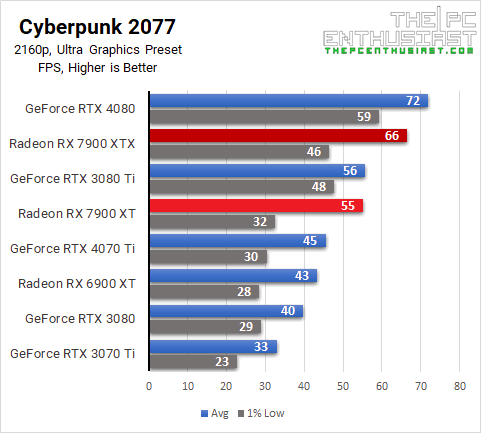


Unfortunately, the RX 7900 XTX could not outperform its competition in this game title. I was already expecting this since Cyberpunk 2077 favors NVIDIA’s GPUs. The RX 7900 XTX got left behind the moment ray tracing was enabled. Enabling FSR didn’t help much either, and it barely got 60fps on 1440p.
Forza Horizon 5
Forza Horizon 5 is another game that has ray tracing features. However, this game’s ray tracing is less intensive than Cyberpunk 2077. Below are the results:



The Radeon RX 7900 XTX couldn’t outperform the RTX 4080 in this game with RT enabled. The RTX 4070 Ti slightly beat it in 1080p and 1440p as well. However, at 4K, it somehow got closer to the RTX 4080.
The Witcher 3: Next-Gen
Last but not least, I tested the Radeon RX 7900 XTX with the Witcher 3 Next Gen update. However, I noticed that with the next-gen update, the game somehow became “unoptimized”. I sometimes get crashes, and with the new 4.01 patch, the frame rates dropped even further. I was able to finish benchmarking these graphics cards before the 4.01 patch. But I am looking forward to the developers releasing a new patch to fix this game’s performance issues.






As you can see from the results above, most graphics cards performed similarly at 1080p at 1440p with traditional rasterization. It was only at 4K that we saw some performance difference between each GPU. Nevertheless, the Radeon RX 7900 XTX can drive the Witcher 3 quite well, even at 4K resolution.
Enabling the ray tracing features did make the RX 7900 XTX struggle. Even after enabling FSR 2.0, I couldn’t get 60 fps, even at 1440p resolution. Looking at the results I got, I think there’s something wrong with the next-gen update. The game devs need to fix the next-gen update fast, and I hope to see a patch that will fix the performance issue soon.
Pricing and Availability
The Radeon RX 7900 XTX is now available and has been in the market since December 2022. There is the reference design card, like the one we reviewed, and there are custom RX 7900 XTX from AIC partners. The AMD Radeon RX 7900 XTX has a SEP of $999 USD, while the AMD Radeon RX 7900 XT has a SEP of $899 USD. AMD is known for adjusting its CPU and GPU prices a few months after the product has been released. So, kindly follow the links below for the latest pricing and availability.
UPDATE: It’s July 2023 and I expect some price adjustments. Luckily, some custom-designed Radeon RX 7900 XTX cards are already selling below MSRP. To name some, these are the XFX Speedster MERC310 RX 7900XTX, PowerColor Red Devil RX 7900 XTX, and Sapphire PULSE RX 7900 XTX.
Check the latest pricing and availability: (#ad)
AMD Radeon RX 7900 XTX graphics cards are available on Amazon.com here.
Radeon RX 7900 XT graphics cards are available on Amazon.com here.
AMD Radeon RX 7900 XTX Review Conclusion
You have seen the results above, and the results speak for themselves. I think AMD did a great job with its Radeon RX 7900 XTX based on RDNA 3 architecture. The performance of the RX 7900 XTX was pretty decent, considering that it’s cheaper than its primary competition.
I like the reference design. It looks sleek with its all-black color scheme and red accent. If you want a more gamer-vibe design, you can check out the Sapphire Nitro+ Radeon RX 7900 XT Vapor-X. It’s a little bit above the MSRP, but it’s big, chunky, and has RGB lighting. However, if you want something on a discount, at the time this review was published, the XFX Speedster MERC310 Radeon RX 7900XT Ultra Gaming retails for $880 only.
My reference RX 7900 XTX ran relatively cool and silent. Its thick aluminum heatsink and vapor chamber were sufficient to cool the GPU. My peak temperature was around 75 °C, and I assume custom-cooled RX 7900 XTX from AIC partners will have a lower temperature. The highest clock speed it got was around 3007MHz, stock, and no overclocking involved. Unfortunately, I did notice some coil whine noise, especially at 4K resolution. But coil whine can vary from one unit to another.
A Few Concerns
While I am impressed with the performance of the RX 7900 XTX, there are a few concerns that I want to mention. First, while its traditional rasterization is excellent and can compete, if not outperform its competition, the RX 7900 XTX still needs to catch up when it comes to ray tracing and upscaling technology. Not to mention, they don’t have frame generation either. Although, as I read from different forums and social media, some gamers are not fans of “fake frames”.
If NVIDIA suddenly drops the price of the RTX 4080, AMD might have difficulty selling the RX 7900 XTX at its current price. I do hope AMD can catch up when it comes to ray tracing and upscaling technology very soon. But I’m not sure if they can improve ray tracing support with the current generation and architecture.
Another thing that I do not like and appreciate is the current naming scheme. It’s fine that they named the RX 7900 XTX as it is, but at least they could have called the RX 7900 XT differently. It can be confusing and misleading, especially for the uninitiated and unfamiliar with these new GPUs.
Finally…
Anyway, at the end of the day, I think AMD’s Radeon RX 7900 XTX is an excellent graphics card. Although it needs to catch up when it comes to ray tracing performance, it is faster, if not on par, when it comes to traditional rasterization versus its competition. It is also cheaper than the RTX 4080, by around $200~$300+ or so at the current market. If you need a fast graphics card for 4K or 1440p gaming and ray tracing is not your primary target, AMD’s Radeon RX 7900 XTX is definitely worth putting at the top of your list.


